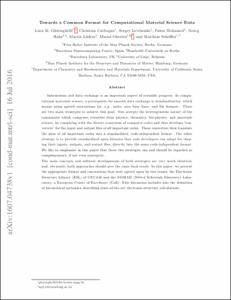Mostra el registre d'ítem simple
Towards a Common Format for Computational Material Science Data
| dc.contributor.author | Ghiringhelli, Luca M. |
| dc.contributor.author | Carbogno, Christian |
| dc.contributor.author | Levchenko, Sergey |
| dc.contributor.author | Mohamed, Fawzi |
| dc.contributor.author | Huhs, Georg |
| dc.contributor.author | Lüders, Martin |
| dc.contributor.author | Oliveira, Micael |
| dc.contributor.author | Scheffler, Matthias |
| dc.contributor.other | Barcelona Supercomputing Center |
| dc.date.accessioned | 2016-09-21T14:50:23Z |
| dc.date.available | 2016-09-21T14:50:23Z |
| dc.date.issued | 2016-07-16 |
| dc.identifier.citation | Ghiringhelli, Luca M. [et al.]. "Towards a Common Format for Computational Material Science Data". 2016. |
| dc.identifier.uri | http://hdl.handle.net/2117/90126 |
| dc.description | Preprint arXiv:1607.04738 |
| dc.description.abstract | Information and data exchange is an important aspect of scientific progress. In computational materials science, a prerequisite for smooth data exchange is standardization, which means using agreed conventions for, e.g., units, zero base lines, and file formats. There are two main strategies to achieve this goal. One accepts the heterogeneous nature of the community which comprises scientists from physics, chemistry, bio-physics, and materials science, by complying with the diverse ecosystem of computer codes and thus develops “converters” for the input and output files of all important codes. These converters then translate the data of all important codes into a standardized, code-independent format. The other strategy is to provide standardized open libraries that code developers can adopt for shaping their inputs, outputs, and restart files, directly into the same code-independent format. We like to emphasize in this paper that these two strategies can and should be regarded as complementary, if not even synergetic. The main concepts and software developments of both strategies are very much identical, and, obviously, both approaches should give the same final result. In this paper, we present the appropriate format and conventions that were agreed upon by two teams, the Electronic Structure Library (ESL) of CECAM and the NOMAD (NOvel MAterials Discovery) Laboratory, a European Centre of Excellence (CoE). This discussion includes also the definition of hierarchical metadata describing state-of-the-art electronic-structure calculations. |
| dc.description.sponsorship | This project has received funding from the European Union’s Horizon 2020 research and innovation program under grant agreement No 676580, The NOMAD Laboratory, a European Center of Excellence, and the BBDC (contract 01IS14013E). We thank James Kermode and Saulius Gražulis for their contribution to the discussion on the metadata, and Pasquale Pavone for precious suggestions on the metadata structure and names. We thank Patrick Rinke for carefully reading the manuscript. We thank Claudia Draxl and Kristian Thygesen for their contribution to the discussions on the necessary information to be stored for excited-state calculations and on the error bars and uncertainties. We gratefully acknowledge Damien Caliste, Fabiano Corsetti, Hubert Ebert, Jan Minar, Yann Pouillon, Thomas Ruh, David Strubbe, and Marc Torrent for their contributions to the ESCDF specifications. We acknowledge inspiring discussions with Georg Kresse, Peter Blaha, Xavier Gonze, Bernard Delley, and Jörg Hutter on the energy-zero definition and scalar-field representation. We thank Ole Andersen, Evert Jan Baerends, Peter Blaha, Lambert Colin, Bernard Delley, Thierry Deutsch, Claudia Draxl, John Kay Dewhurst, Roberto Dovesi, Paolo Giannozzi, Mike Gillan, Xavier Gonze, Michael Frisch, Martin Head-Gordon, Juerg Hutter, Klaus Koepernik, Georg Kresse, Roland Lindh, Hans Lischka, Andrea Marini, Todd Martinez, Jens Jørgen Mortensen, Frank Neese, Richard Needs, Taisuke Ozaki, Mike Payne, Angel Rubio, Trond Saue, Chris Skylaris, Jose Soler, John Stanton, James Stewart, Marat Valiev for checking the information provided in Table 1 and for useful suggestions. |
| dc.format.extent | 16 p. |
| dc.language.iso | eng |
| dc.subject | Àrees temàtiques de la UPC::Enginyeria electrònica |
| dc.subject.lcsh | Algorithms--Data processing |
| dc.subject.lcsh | Data storage |
| dc.subject.lcsh | Computational sciences |
| dc.subject.other | High-throughput screening |
| dc.subject.other | Computational materials science |
| dc.subject.other | Data exchange |
| dc.title | Towards a Common Format for Computational Material Science Data |
| dc.type | Other |
| dc.subject.lemac | Estructures de dades (Informàtica) |
| dc.subject.lemac | Ordinadors--Dispositius de memòria |
| dc.relation.publisherversion | https://arxiv.org/abs/1607.04738 |
| dc.rights.access | Open Access |
| dc.description.version | Preprint |
| dc.relation.projectid | info:eu-repo/grantAgreement/EC/H2020/676580/EU/The Novel Materials Discovery Laboratory/NoMaD |
Fitxers d'aquest items
Aquest ítem apareix a les col·leccions següents
-
Altres [2]


